Loading...
August 7, 2025
Camping in Iceland: Top Tips, Rules and South Iceland Sites
Camping in Iceland is one of the most immersive and flexible ways to experience the country’s stunning landscapes, geothermal wonders, and hidden natural gems. With a campervan or tent, you can travel at your own pace, falling asleep under the Northern Lights and waking up each day to glaciers, waterfalls, volcanoes, or lush valleys within arm's reach.
However, Iceland is a unique country. There are certain rules around camping, and you might have questions about what equipment is required or where the best campsites are. Have no fear, here we’ll run through everything you need to know about camping in Iceland, including what to bring, important camping guidelines, and a list of the best places to camp in South Iceland.
Why Choose Camping in Iceland?
Whether you’re touring the Ring Road or focusing your journey on the south, camping is an adventurous and budget-friendly way to travel. With hundreds of campsites scattered around the country, many offering all the modern conveniences like WiFi, hot showers, and kitchens, you’ll have the freedom to venture off the beaten track in comfort. From tents to modern campervans, you’ll be able to experience Iceland’s natural beauty up close.
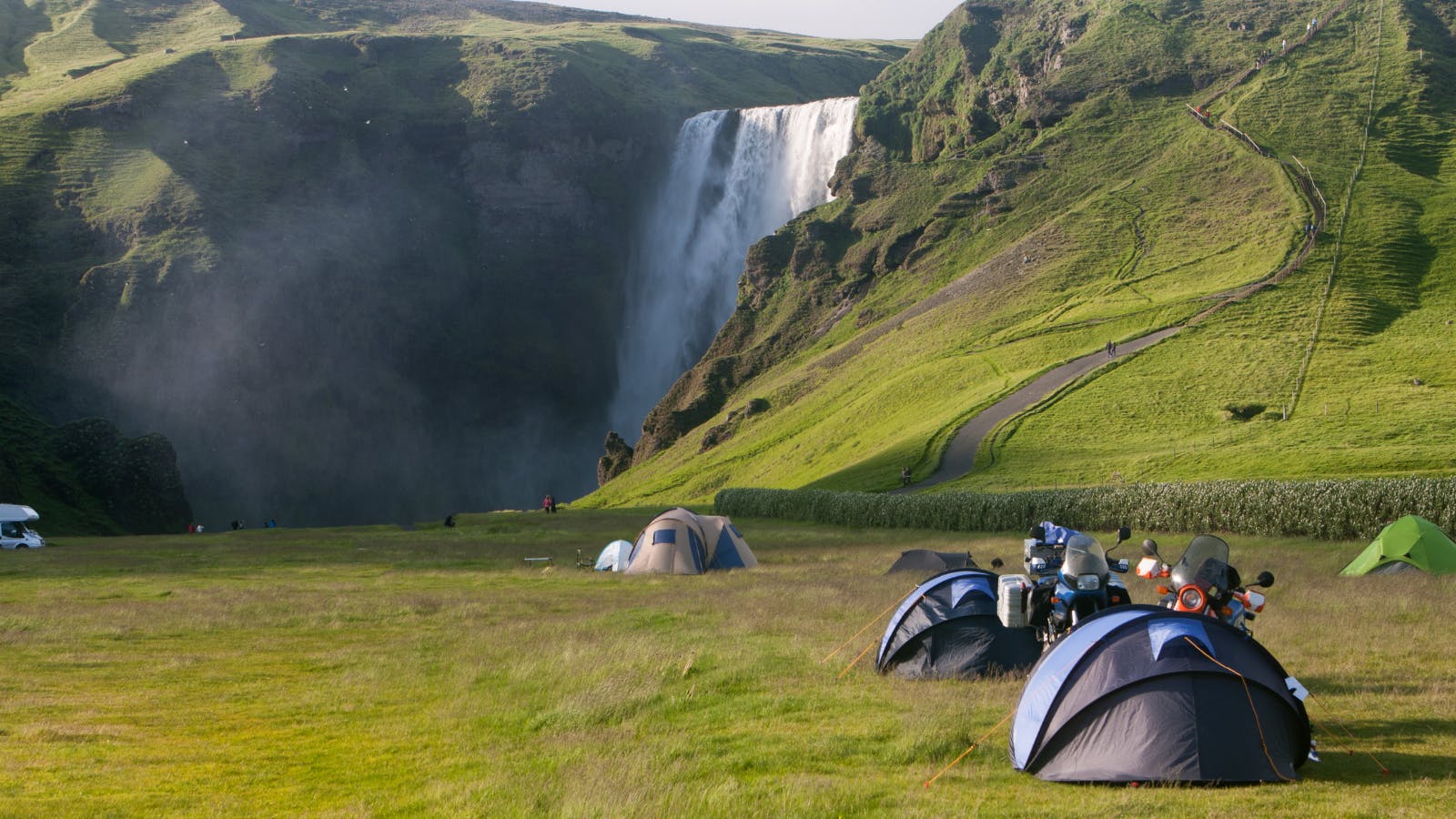
Camping Rules in Iceland - Where Am I Allowed to Camp?
In order to protect its delicate ecosystem and reduce human impact, Iceland has strict rules about where you can and cannot spend the night. The influx of tourists could easily cause lots of damage, so it is important that there are regulations in place to preserve the environment. As a visitor, you are allowed to camp in the following areas:
- Designated campsites
- Private land (with the owner's permission)
It is not permitted to sleep overnight in your vehicle at the side of the road. And remember, off-road driving in Iceland is illegal, so you must not do this to find somewhere to camp.
If you are hiking in an uninhabited area and there are no campsites in the vicinity, you may be able to spend the night in a tent, but not in a campervan. However, there are strict rules surrounding this.
It’s probably best to be on the safe side and arrange to stay in designated campsites where possible. That being said, as long as you do your research and follow the law, you have innumerable places to camp. Just make sure to find the owner and get their permission first.
Wherever you decide to camp overnight, make sure you never leave anything behind. Others will come after you, and you should aim to give them the same experience you had, in unspoiled nature with stunning views.
Equipment for Camping in Iceland
The items you’ll need to bring for your camping trip in Iceland depend on a few factors. Firstly, whether you are renting a campervan or using a tent. You’ll also need to consider the types of campsites you’ll be staying in, as some sites are fully equipped with amenities, while others are more basic. Opting for a campsite with better facilities is likely to cost slightly more, but it will mean you can travel lighter. Want to avoid bringing your own tent? You can rent a tent to save on luggage.
Most campervans tend to come equipped with the essentials; however, a general rule of thumb when camping in Iceland in either a tent or campervan is to make sure you have the following on hand:
- Suitable clothing, including waterproof outer layers, like jackets and pants. Items that can be layered, like sweaters or fleeces, strong hiking boots, swimsuits for campsite pools or geothermal springs, a hat, and gloves.
- Sleeping pad with appropriate insulation, sleeping bag suitable for low temperatures
- Portable cooking items like a stove, a kettle, and fuel for both, cooking utensils, and cookware
- Towels
- Flashlights or lanterns
- Foldable camping chairs
- Power bank or portable charger
- Trash bags for waste
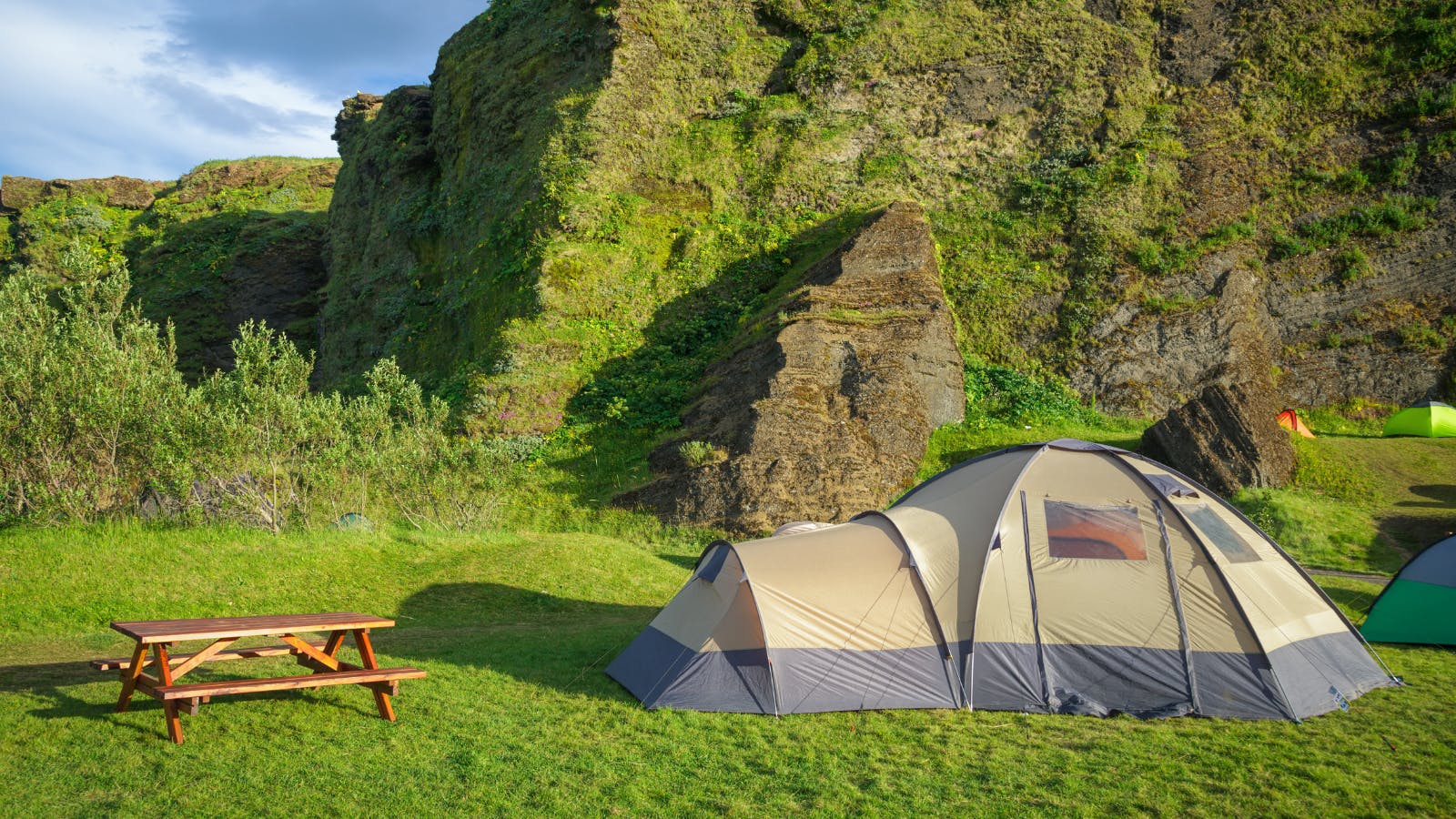
Best Campsites in South Iceland
South Iceland is one of the most scenic and accessible regions for camping, offering easy access to waterfalls, glaciers, geothermal hot springs, and iconic stops along the famous Golden Circle. Here are some of South Iceland's most popular campsites.
1. Kleifar-Mörk Campsite
When it comes to campsites in South Iceland, Kleifar-Mörk is definitely the best-kept secret. Located at Geirlandsvegur, between Vík and Jökulsárlón (glacial lagoon), it is a relatively small campsite, with a price tag and amenities to match. At the back of the campsite lies the stunning Stjórnarfoss Waterfall. Depending on geothermal conditions, the water can sometimes be warm enough for a swim!
Opening Times: 1st Jun – 31st Aug
Price: 750 ISK per person (or free if you have a camping card!)
Location: Geirlandsvegur, 880 Kirkjubæjarklaustur, Iceland
2. Reykjavík-Eco Campsite
This campsite is located in the heart of Reykjavík, meaning you will have easy access to the vibrant city life at play in the capital. At the same time, its proximity to green spaces means you can also easily go on hikes or cycle through the surrounding valleys. This modern campsite is family-friendly and boasts an assortment of amenities, including showers, laundry, a lounge area, and a guest kitchen. After a long day, you can even relax at the Laugardalslaug geothermal pool.
Opening Times: All year round
Price: From 3,950 ISK (per adult per night)
Location: Sundlaugavegur 32, 105 Reykjavík, Iceland
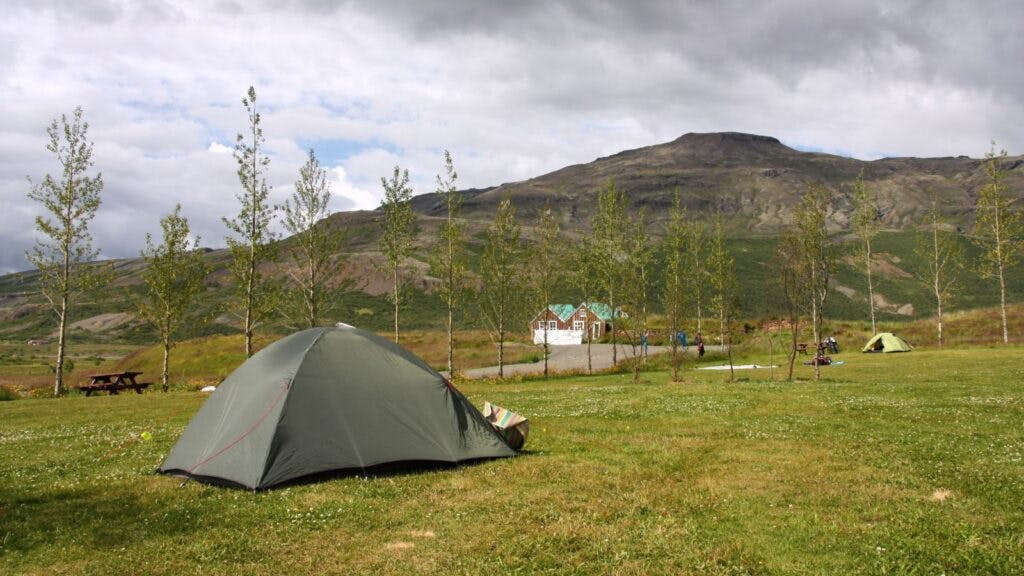
3. Þórsmörk
Situated in the shadow of the Eyjafjallajökull Volcano, Þórsmörk is a sanctuary of birch trees, moss, volcanic rocks, birds, arctic foxes, and even elves! There are several campsites and mountain huts across the valley of Thor. You can even explore two of Iceland’s most famous hiking trails - the Fimmvörðuháls Hike and Laugavegur Trail. Just remember to wear proper hiking gear and seek expert guidance if you’re unsure.
Opening Times: 10th Jun - 31st Aug
Price: 2,900 ISK
Location: 861 Þórsmörk, Iceland
4. Gata Free Camping Site
Just outside of Þorlákshöfn on the south coast of Iceland lies a free campsite called Gata. If you’re familiar with how good Icelandic hot dogs are, you’ll want to try this campsite for sure. There’s a hot dog stand here where you can enjoy this delicacy! There are restrooms, showers, and cooking spaces, but electricity is not available. There’s no better way to embrace the true spirit of camping.
Opening Times: All year round (but facilities close once it starts snowing)
Price: Free
Location: 816 Strandakirkja, Iceland
5. Skaftafell Campsite
If the Ring Road is part of your South Iceland camping itinerary, you’ll inevitably come across Skaftafell - a wilderness area in the Vatnajökull National Park. At the foot of the Hvannadalshnúkur Mountain lies the campsite. It’s the perfect base for a number of outdoor activities. You can embark on a short but steep trek to the Svartifoss Waterfall (The Black Waterfall), or try activities such as glacier hiking and ice climbing in the surrounding glaciers.
Opening Times: All year round
Price: From 2,800 ISK
Location: 785 Skaftafell, Iceland
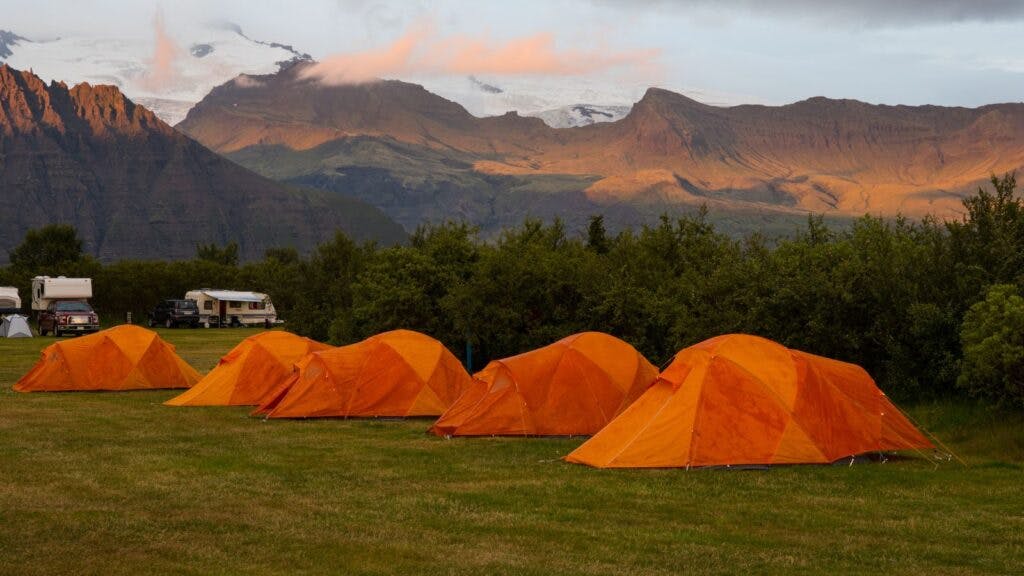
6. Skógar Campsite
Just a few meters from the Skógafoss Waterfall lies the Skógar campsite. It is ideal for starting the Fimmvorduhals hiking trail and also serves as the finish point. You will come across volcanic craters, glaciers, and stunning panoramic views on this trail. The Skógar campground in South Iceland unites nature lovers from around the world.
Opening Times: All year round
Price: 1,800 ISK
Location: 861 Eyvindarhólar, Iceland
7. Grindavík Campsite
If you want to dive into your Iceland camping experience straight after landing at Keflavík, the Grindavík campsite on the Reykjanes Peninsula is very close by. Once you’ve set up camp, you can start exploring all that the region has to offer. There is Reykjanesviti - the oldest lighthouse in Iceland - where you’ll find stunning coastal views, the Gunnuhver geothermal area, the Hafnaberg Cliffs, the Viking World Museum, and lots more to discover. And at the end of a long day, the Blue Lagoon is just 4.8 kilometers away for a relaxing soak!
Opening Times: 1st Mar - 1st Dec
Price: 2,400 ISK (per adult per night)
Location: Austurvegur 26, 240 Grindavík, Iceland
8. Úlfljótsvatn
If you’re camping in South Iceland with kids, then Úlfljótsvatn is by far the most fun-filled campsite. Supervised by local scouts, this campsite has exceptional play areas such as a soccer field, volleyball field, water safari, climbing tower, and a frisbee golf course! The campsite sits across the scenic Lake Úlfljótsvatn, offering a relaxing time spent in the raw nature that Iceland is famed for.
Opening Times: 1st Jun - 15th Nov (services are limited from 1st Sept)
Price: 1,950 ISK (adults), 700 ISK (13 to 17 years), Free (12 years and under)
Location: Úlfljótsvatn, 801 Selfoss, Iceland
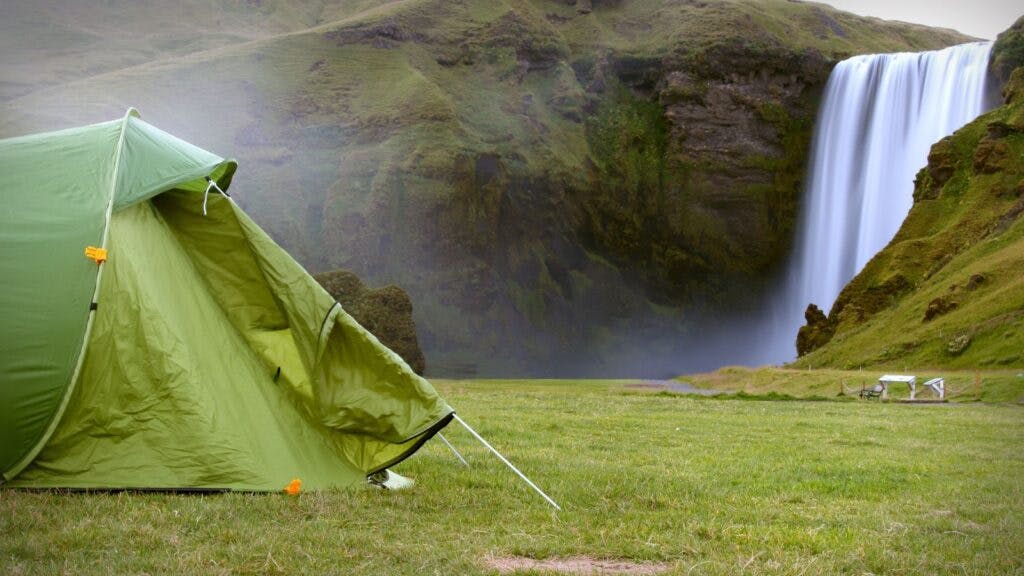
9. Kerlingarfjöll Campground
Kerlingarfjöll is the hikers’ campsite. Located in the Highlands of Iceland, the campsite is only accessible with a 4x4. There are numerous hiking trails leading into the Icelandic wilderness, making Kerlingarfjöll a paradise for nature lovers. The campsite has modern amenities, including a restaurant offering breakfast, lunch, and dinner, where you can also purchase a sandwich to take with you on your hike!
Opening Times: 15th Jun - 30th Sept
Price: 3,000 ISK
Location: Kerlingarfjöll Highland Resort, Kjölur 35, Iceland
10. Þjórsárdalur Campground
On the shores of the Þjórsá, the longest river in Iceland, lies the Þjórsárdalur campground and the small forest it is sheltered within. If you’re looking for a peaceful escape, this is the place for you.
About 8 kilometers (5 miles) from the campsite is a reconstructed medieval farmhouse called Þjóðveldisbærinn Stöng. Just 3.2 kilometers (2 miles) away is another early medieval farmhouse called Stöng. The beautiful waterfalls, Háifoss and Hjálparfoss, are also worthwhile attractions in the area, as is the fairytale land of Gjáin.
Opening Times: 15th May - 15th Sept (or until the frost arrives)
Price: 1,800 ISK
Location: Þjórsárdalsvegur, 804, Iceland
Ready to Go Camping?
Camping in Iceland, especially in the south, is one of the best ways to experience the country. From lakes and rivers to mountains and glaciers, camping offers a unique way to explore the natural wonders of this Nordic country.
Camping in Iceland FAQs
Is Wild Camping Allowed in Iceland?
There are only a small number of situations in which wild camping would be permitted in Iceland. Such as if you were in a tent, in an uninhabited area with no campsites in the vicinity. Generally, camping outside of campsites is only allowed in tents and with permission from the landowner. These strict regulations are in place to protect Iceland’s fragile environment, so they must be respected.
How Much Do Campsites Cost in Iceland?
Costs for staying in campsites in Iceland vary, typically depending on the facilities they have to offer. You can expect to pay between 1,500 ISK and 3,500 ISK in most places. The cost is usually per adult, and children are often free. Iceland also operates a Camping Card scheme, which allows members to stay at various campsites for free or at a discounted rate.
What Time of Year Can I Go Camping in Iceland?
Many of Iceland’s campsites are seasonal and close during the height of winter. However, there are some locations that are open throughout the year. You may find that facilities at these campsites are limited during the winter months.
Do I Need to Book Campsites in Advance?
Depending on where you want to stay, it may be beneficial to book your space - especially near popular attractions or during the peak season. However, some campsites are first-come, first-served, meaning you may need to book your slot in the morning and then head out for the day.
What Kind of Vehicle Do I Need for Camping in Iceland?
If you are travelling with lots of camping equipment, you'll need a vehicle with plenty of space for all your gear. You will also need to consider the driving routes to and from your camping destinations - the Highland areas can only be accessed by F-Roads, which means you will need a 4x4 vehicle.

